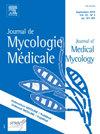Identification, quantification, and bioactivity of Vitex negundo phenolic acids as efficacious anti-candidal and antibiofilm agents targeting Candida albicans
IF 1.8
4区 医学
Q3 MYCOLOGY
引用次数: 0
Abstract
Phenolic acids derived from the leaf of Vitex negundo have been widely recognized for their natural antifungal properties. This study evaluates the bioactive potential of these phenolic acids against Candida albicans, a significant fungal pathogen responsible for various infections in humans. The total phenolic content (TPC) of the plant extract was quantified using the Folin-Ciocalteu reagent and expressed in terms of gallic acid equivalent (GAE), with a TPC of 90.1 ± 3.36 mg GAE/g dry weight extract. The antioxidant activity, measured through the DPPH radical scavenging assay, demonstrated a substantial inhibition rate of 60.776 ± 2.32 % at 1 mg/mL concentration. LCMS analysis identified 18 phenolic acids, with p-coumaric acid showing the highest concentration at 34.3575 µg/ml. In-silico screening highlighted chlorogenic acid, caffeic acid, coumaric acid, and 2,4-dihydroxybenzoic acid having the top four compounds with antifungal potential, which was further validated through in-vitro assays. Caffeic acid emerged as the most potent anti-candidal agent (among these 4 shortlisted compounds) with an MIC of 64 ± 2.31 µg/ml, exhibiting both fungistatic and fungicidal effects. The FE-SEM analysis confirmed the complete eradication of C. albicans biofilm and significant membrane damage post-treatment with caffeic acid. These findings underscore the dual mechanisms of action, i.e., antioxidant and anti-candidal potential of V. negundo phenolic extracts, presenting them as promising candidates for developing natural anti-candidal therapeutics. Future research should explore the molecular interactions and potential synergistic effects with other antimicrobial agents to enhance efficacy and mitigate drug resistance development.
白念珠菌有效抗念珠菌和抗生物膜剂牡荆酚酸的鉴定、定量和生物活性研究
从牡荆叶中提取的酚酸因其天然的抗真菌特性而被广泛认可。本研究评估了这些酚酸对白色念珠菌的生物活性潜力,白色念珠菌是人类各种感染的重要真菌病原体。采用Folin-Ciocalteu试剂定量测定植物提取物总酚含量(TPC),以没食子酸当量(GAE)表示,TPC为90.1±3.36 mg GAE/g干重提取物。通过DPPH自由基清除实验测定其抗氧化活性,在1 mg/mL浓度下,其抑制率为60.776±2.32%。LCMS分析鉴定出18种酚酸,其中对香豆酸浓度最高,为34.3575µg/ml。在体外筛选中,绿原酸、咖啡酸、香豆酸和2,4-二羟基苯甲酸具有较强的抗真菌潜力,并通过体外实验进一步验证。咖啡酸是4种候选化合物中最有效的抗念珠菌剂,其MIC为64±2.31µg/ml,具有抑菌和杀真菌作用。FE-SEM分析证实了咖啡酸处理后白色念珠菌生物膜的完全根除和明显的膜损伤。这些发现强调了紫花葡萄酚提取物的双重作用机制,即抗氧化和抗念珠菌的潜力,使它们成为开发天然抗念珠菌疗法的有希望的候选者。未来的研究应探索与其他抗菌药物的分子相互作用和潜在的协同作用,以提高疗效和减轻耐药性的发展。
本文章由计算机程序翻译,如有差异,请以英文原文为准。
求助全文
约1分钟内获得全文
求助全文
来源期刊
CiteScore
5.10
自引率
2.80%
发文量
68
审稿时长
6-12 weeks
期刊介绍:
The Journal de Mycologie Medicale / Journal of Medical Mycology (JMM) publishes in English works dealing with human and animal mycology. The subjects treated are focused in particular on clinical, diagnostic, epidemiological, immunological, medical, pathological, preventive or therapeutic aspects of mycoses. Also covered are basic aspects linked primarily with morphology (electronic and photonic microscopy), physiology, biochemistry, cellular and molecular biology, immunochemistry, genetics, taxonomy or phylogeny of pathogenic or opportunistic fungi and actinomycetes in humans or animals. Studies of natural products showing inhibitory activity against pathogenic fungi cannot be considered without chemical characterization and identification of the compounds responsible for the inhibitory activity.
JMM publishes (guest) editorials, original articles, reviews (and minireviews), case reports, technical notes, letters to the editor and information. Only clinical cases with real originality (new species, new clinical present action, new geographical localization, etc.), and fully documented (identification methods, results, etc.), will be considered.
Under no circumstances does the journal guarantee publication before the editorial board makes its final decision.
The journal is indexed in the main international databases and is accessible worldwide through the ScienceDirect and ClinicalKey platforms.

 求助内容:
求助内容: 应助结果提醒方式:
应助结果提醒方式:


